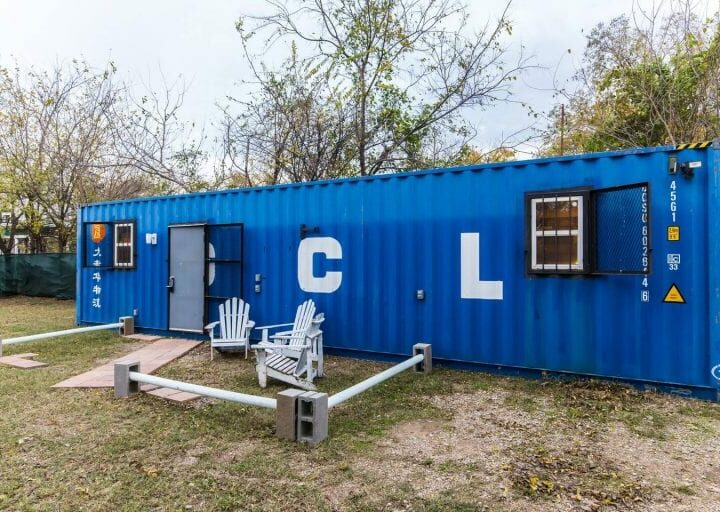Shipping containers are widely used around the world for transporting goods by sea.
Global cargo shipping reached 1.85 billion metric tons in 2020, up from 0.1 billion metric tons in 1980. This growth was primarily driven by the expansion of containerized shipping, which now accounts for more than 60 percent of global maritime trade.
In recent years, however, shipping containers have been repurposed as homes and other structures. Containers are an attractive option for housing and other purposes because they are strong, modular, and relatively inexpensive.
Read along to know more shipping container statistics and why they are an excellent option for your dream home.

Shipping container statistics and history
Shipping containers or intermodal containers are large, standardized containers used to move goods by ship, rail, or truck.
They come in two main types: ISO (International Organization for Standardization) containers for international shipping and domestic containers for domestic shipping.
Here are some interesting shipping container statistics on market value:
- The market for ISO containers stood at 552 thousand units in 2018, projected to reach 1,093.5 thousand units by 2026. The CAGR (compound annual growth rate) is forecasted to be 8.8% from 2019 to 2026. (Source: Fortune Business Insights)
- The international shipping trade industry is responsible for carrying out 90% of the world trade, which will fuel the growth of ISO containers throughout the forecast period. (Source: Fortune Business Insights)
- The Road segment comprises the leading market share among ISO containers (50%), followed by Rail and Marine. (Source: Fortune Business Insights)
Shipping containers come from a long history of containerized shipping, which began in the early 20th century. These containers were first used to move coal and bulk commodities by rail in the United States.
In 1956, Malcolm McLean patented the modern shipping container, which was used to ship goods by truck and ship.
Different types of shipping containers
There are different shipping containers, each designed for a specific purpose:
- Standard containers come in two sizes: 20-foot and 40-foot containers. These can be used to ship almost any type of goods and comprise 85% of all containers worldwide. (Source: Container Services International)
- Refrigerated containers or reefers can ship perishable goods, such as food and pharmaceuticals. Reefers have a temperature-controlled environment and can lower moisture levels between 60% and 85% relative humidity. (Source: Kuehne + Nagel)
- Flat-rack containers are used to ship heavy or oversized cargo that cannot be shipped in a standard container. They have no walls or roof, and their sides can be folded for easy loading and unloading.
- Open-top containers are used to ship tall cargo, such as machinery or vehicles. They have a removable roof for easy loading and unloading.

Container homes statistics
Nowadays, people are using shipping containers to build homes because they are strong, durable, weatherproof, and easily transportable.
Additionally, they are sustainable (made from recycled materials), affordable (compared to traditional stick-built homes), and can be built quickly (since they come pre-fabricated).
Premade shipping container homes cost around $10,000, while small but luxurious ones may cost as much as $35,000. Larger container homes may cost up to $185,000, which is still less expensive than the average cost of a house in the United States.
- Shipment containers depreciate over 13 years before they are repurposed as stationary storage space or container homes. (Source: Triton)
- The global market for container homes is expected to reach $73,070.5 million by 2025 from $44,768.6 million in 2017. This is forecasted to grow at a CAGR of 6.5% from 2018 to 2025. (Source: Allied Market Research)
- Over 14 million out-of-service shipping containers are easily available in the market at a low cost for building container homes. (Source: Allied Market Research)
- Old shipping containers hold the maximum market share for container homes, which was 77.3% in 2017. (Source: Allied Market Research)
- Heavily used but maintained container homes can last 10-15 years. If not used as often, they can last up to 25 years. Some claim they can reach 100 years with the highest maintenance and upkeep. (Source: The Business Research Company)
- Up to 3500 kg of steel can be recycled from 40-foot shipping containers to build container homes. (Source: The Business Research Company)

Final Thoughts
Our compilation of shipping container statistics clearly shows the importance of these versatile vessels.
Shipping containers have long been used in the logistics industry for the transport of goods across land and sea. With its ever-growing demand due to the globalization of trade, its popularity has only increased in recent years.
One of the most popular uses for shipping containers has been the construction of container homes.
You can create durable and affordable homes from these containers. Moreover, they are perfect for people who want to live in a green and sustainable way as they are made from recycled materials.
Building a container home is a great way to save money and have a unique home that will last for many years.

